| << UbuWeb |
| Aspen no. 8, item 10 |
|
|
|
The Young Turtle Assymetries
For accompanying audio, listen to item 5 |
|
INTRODUCTION TO THE YOUNG TURTLE ASSYMETRIES Asymmetries are nonstanzaic chance-generated poems of which the printed formats are notations for solo or group performances. They are asymmetrical in that they have no regularly repeating stanzaic or other patterns. They are notations in that most aspects of their format can be translated into aspects of performance. Notably, the lengths of blank space before, between, & after single words or word strings, & between lines, stand for temporal holes -- durations in which readers keep silent or produce single prolonged tones on instruments that can sustain tones evenly (e.g., winds; bowed strings; reed, pipe, or electronic organs; or other mechanical or electronic sound producers). To measure these blanks, each poem page is conceived as a rectangle of which the horizontal sides are the top & bottom lines of words & the vertical sides are imaginary margin lines running parallel through the rightmost & leftmost characters on the page. Blank lines lie between the two margins; righthand blanks, between the right margin & the first character of an indented word; lefthand blanks, between the last printed character & the left margin.
Similarly, phonic holds or prolongations &/or repeats are indicated in some Asymmetries by notations placed in what should otherwise be blank spaces. In the Young Turtle Asymmetries, there are no phonic repeats, but phonic holds or prolongations are represented by a phonemic notation adapted from that used by W. Nelson Francis in his Structure of American English (Ronald Press, New York, 1958), ch. 3: The Significant Sounds of Speech: Phonemics, pp. 119-61 (see esp. chart p. 151). In the order of their introduction, the phonemic notations used in the Young Turtle Asymmetries are:
Single letters are merely repeated to indicate prolongations, while only the final letters of digraphs are repeated. Notations are continued from one line to another by placing hyphens at the ends of lines. However, the 1st letters of digraphs are placed within parentheses at the beginnings of the following lines to remind readers that the sounds indicated by the complete digraphs are to be continued. PERFORMANCE PARAMETERS The durations of silences (or instrumental tones) & prolonged phonemes are at least those of single words or word strings that might be printed in equivalent spaces, as they would be spoken aloud by the individual reader. That is, the reader is silent or prolongs sounds at least as long as it would take him (generic him) to speak such space-equivalent words. However, he may, in performance, extend these durations whenever he feels that the total performance would be better if he remained silent or continued to prolong the sound he is making. Thus the spatial notations are those of minimal durations only; the reader has the option to extend silences & sounds improvisatorially -- in accord with his judgments of the performance situation -- longer than strictly called for by the notation (but he may never make them shorter). In this way, a completely determinate, tho chance generated, notation becomes the basis of only partially determinate -- unpredictable (Feldman) rather than indeterminate (Cage) -- performances. The speed of reading is entirely up to the individual readers, & should be continually varied, but there should be no great disparities in average speed between the fastest & slowest readers. In the Young Turtle Asymmetries, loudness is varied improvisatorially (not by details of the notation, as in other Asymmetries) by individual readers, but only between moderately soft & moderately loud. The pitches of words must be those of normal speech; the pitch of each prolongation should remain as nearly constant as possible, continuing the pitch that the sound would have in normal reading (without longish silences or prolongations) of the phrases in which it occurs. Care should be taken to avoid especially down-glides of a musical third or more (e.g., C to A or below). The Young Turtle Asymmetries must be read by 5 simultaneous readers-. In an optimal performance, all 5 readers will read all 5 Young Turtle Asymmetries, each in one of the following successions: 12345, 23451, 34512, 45123, & 51234. Thus all 5 will always be being read simultaneously. In shorter performances, 1, 2, 3, or 4 of them may be read by each reader, but all 5 must always be read together. It is of the utmost importance that each reader listen very attentively to all sounds produced by himself & the other readers, as well as to all environing sounds (audience, street, &c.). All aspects of performance must be sensitively adjusted by the reader in accord with his perceptions of the total sound. Thus he may prolong a silence, tone, or phoneme, or speak louder or softer, faster or slower, as he feels these actions will contribute most positively to the total sound. SOURCE The words of all 5 Young Turtle Asymmetries were drawn from a single picture caption:
This appeared with the article 100 Turtle Eggs, by Archie Carr, p. 51, Natural History, Vol. Lxxvi, No. 7 (Aug.-Sept. 1967: American Museum of Natural History, New York). The method by which the various words & word strings were drawn in turn from the caption was that of through -acrostic chance generation: e.g., in the 1st Young Turtle Asymmetry, the first words of the caption, up to the 1st punctuation mark, became the 1st words of the poem & the index by which they & the rest were drawn. The 2nd word string begins with found, the first subsequent word having an o in the 2nd place-as in young,- the 3rd word string begins with journey, the next word with a u in the 3rd place, &c. Each time, a word string beginning with a word having the required letter in the required place was taken from that word to the next punctuation mark. A comma (or other non-sentence-ender) made the next line begin on the line below, after one horizontal space; a period made the next line begin 2 lines below, after 2 horizontal spaces. The beginning of a new index word made the line drawn by its initial letter begin at the left margin, & doubled the amount of vertical space between that line & the line before, i.e., below lines ending with commas, double the usual vertical space between lines; after periods, quadruple space. Thus the spelling & punctuation of the words in the caption as well as their original order, both determined how & how much of them were drawn into the poems & how they were spaced on the pages. |
SECTION 10 ASPEN NO. 8 |
Jackson Mac Low |
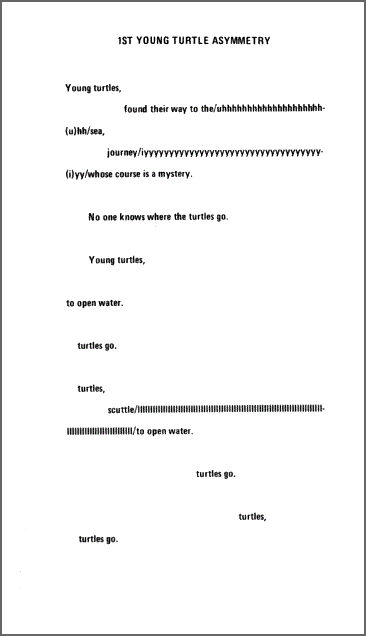
|
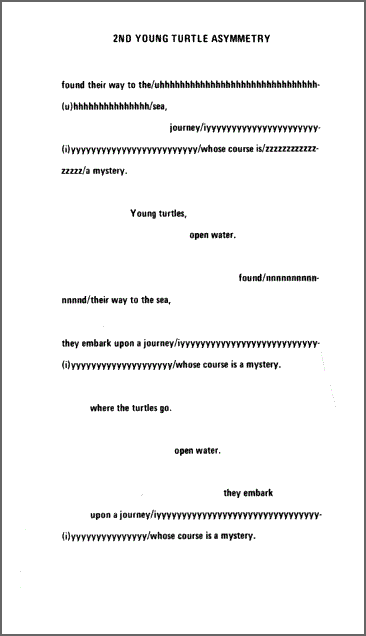
|
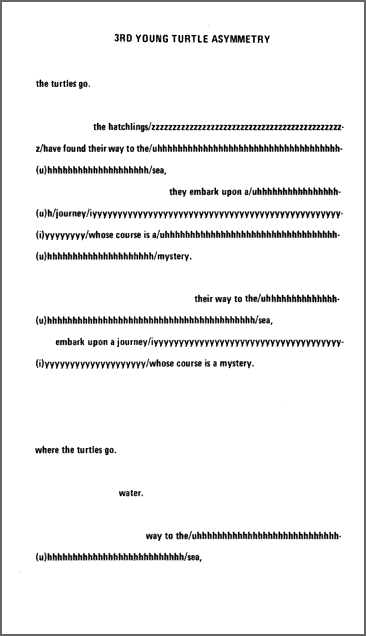
|
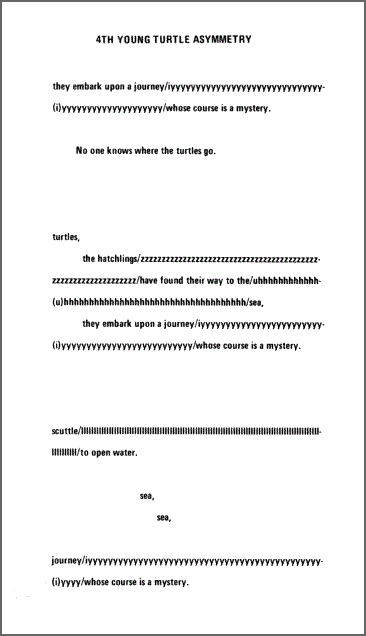
|
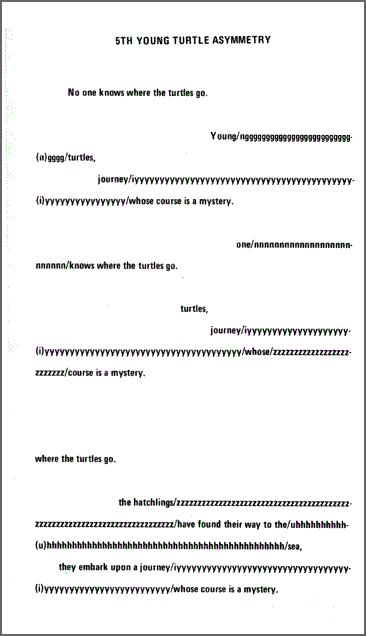
|
|
Original format: 12 by 15 inch perforated sheet, printed on one side. |
|
|
|
|
|
|
|